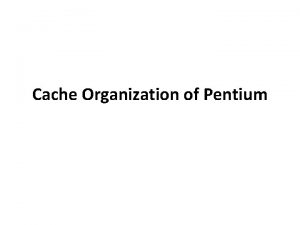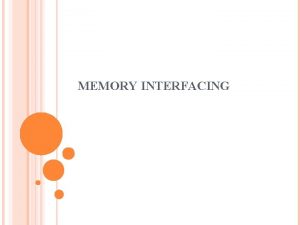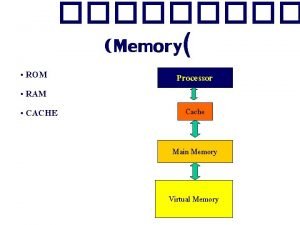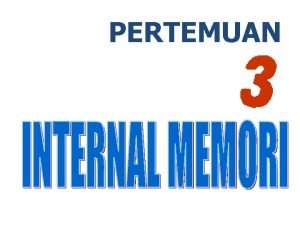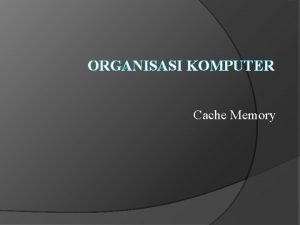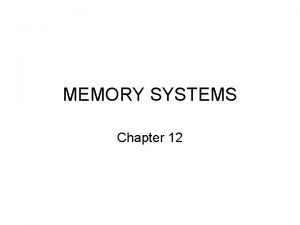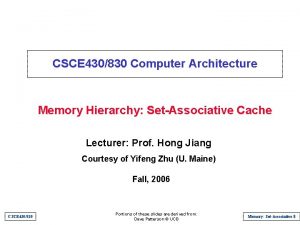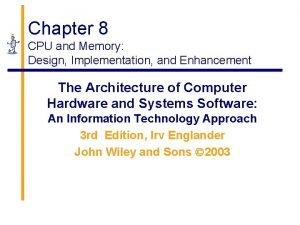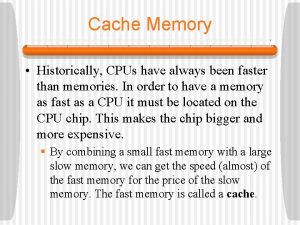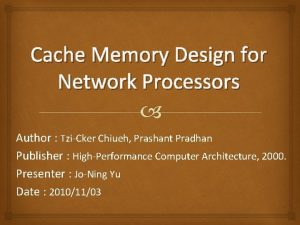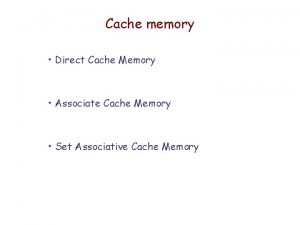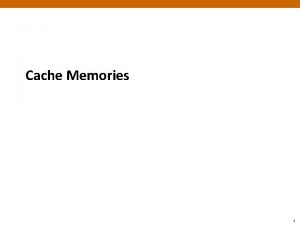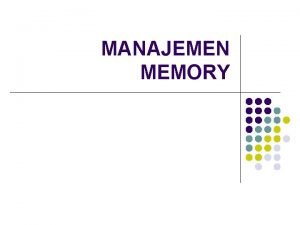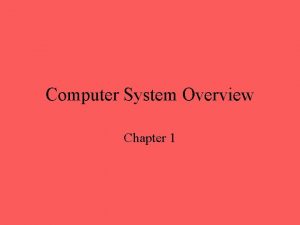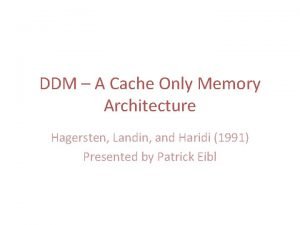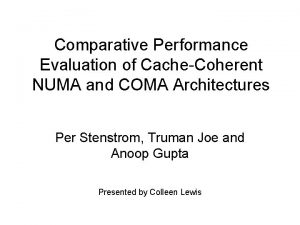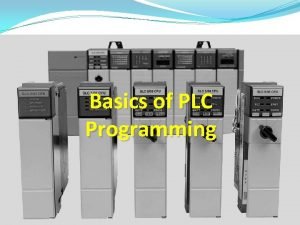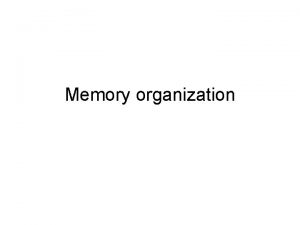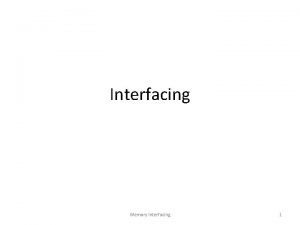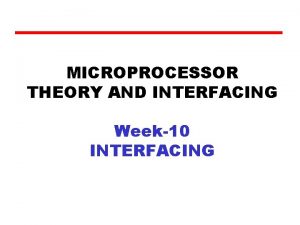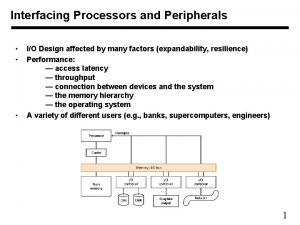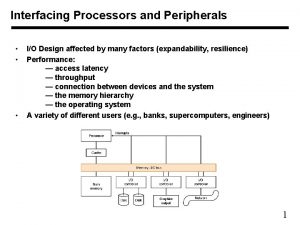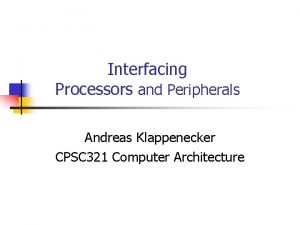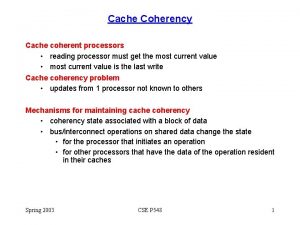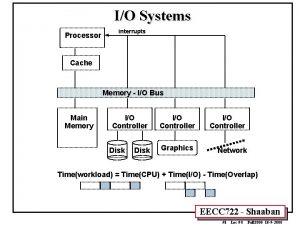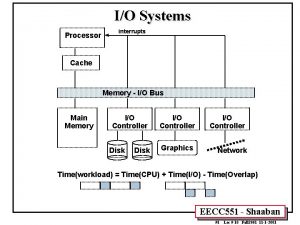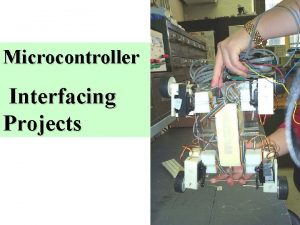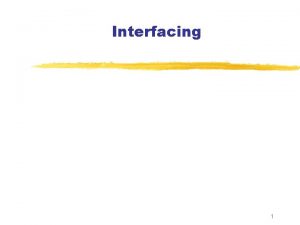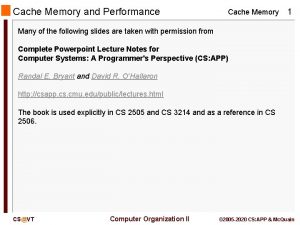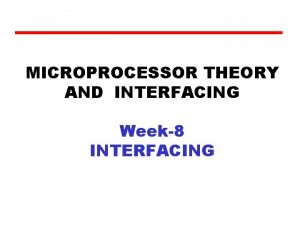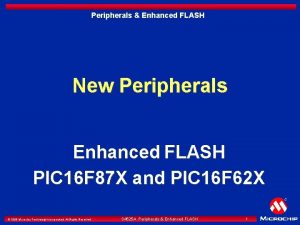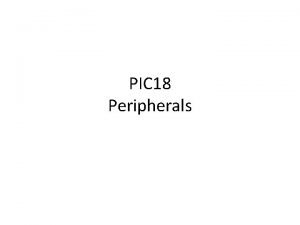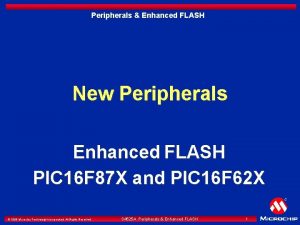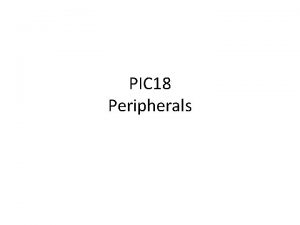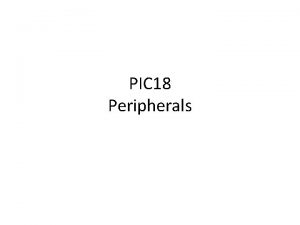Interfacing Processors and Peripherals Processor Interrupts Cache Memory





















- Slides: 21

Interfacing Processors and Peripherals Processor Interrupts Cache Memory– I/O bus Main memory I/O controller Disk I/O controller Graphics output Network 1998 Morgan Kaufmann Publishers 1

I/O Devices 1998 Morgan Kaufmann Publishers 2

Input/Output • Very diverse devices – behaviour (i. e. , input vs. output) – partner (who is at the other end? ) – data rate • Important but neglected – difficulties in assessing and designing I/O systems have often relegated I/O to second class status 1998 Morgan Kaufmann Publishers 3

Input/Output • I/O design affected by performance, expandability, resilience, etc. • I/O System performance depends on: – CPU – memory system (caches, main memory) – buses – I/O controller – I/O device – I/O software (operating system) • Performance metrics: – throughput: I/O bandwidth – response time: latency 1998 Morgan Kaufmann Publishers 4

I/O Example: Disk Drives Platters Tracks Platter Sectors Track To access data: — seek: position head over the proper track ( 6 ms) — rotational latency: wait for desired sector ( 4 ms) — transfer: one or more sectors ( 15 MB/s) 1998 Morgan Kaufmann Publishers 5

Buses • Shared communication link (one or more wires) • Types of buses: – processor–memory (short, high speed, custom design) – backplane (high speed, often standardised, e. g. , PCI) – I/O (lengthy, different devices, standardised, e. g. , SCSI) • Synchronous – use a clock and a synchronous protocol, fast and small – every device must operate at same rate – wait states possible – clock skew requires the bus to be short • Asynchronous – doesn’t use a clock – uses handshaking 1998 Morgan Kaufmann Publishers 6

Bus Design • Difficult – may be a bottleneck – length of the bus – number of devices – tradeoffs (buffers for higher bandwidth increase latency) – support for many different devices – cost 1998 Morgan Kaufmann Publishers 7

Bus Structures Backplane bus Processor Memory a. I/O devices Processor-memory bus Processor Memory Bus adapter I/O bus b. 1998 Morgan Kaufmann Publishers 8

Bus Structures Processor-memory bus Processor Memory Bus adapter I/O bus Backplane bus c. 1998 Morgan Kaufmann Publishers 9

Synchronous Bus Transfer Example: Read T 1 T 2 T 3 Clock Address lines From processor Memory address AS R/W Bidirectional Data lines Data from memory Data accepted by processor 1998 Morgan Kaufmann Publishers 10

Synchronous Bus Transfer Example: Write T 1 T 2 T 3 Clock Address lines From processor Memory address AS R/W Bidirectional Data lines Data from processor 1998 Morgan Kaufmann Publishers 11

Synchronous Write with a Wait State T 1 T 2 Tw T 3 Clock Address lines From processor Memory address AS R/W From memory WAIT Bidirectional Data lines Data from processor WAIT checked by processor 1998 Morgan Kaufmann Publishers 12

Asynchronous Handshaking Example • A device requests a word from the memory • Three control lines – Read. Req: indicates a read request for memory – Data. Rdy: indicates the word is ready on the data lines – Ack: acknowledges the Req or Rdy signal of the other party 1998 Morgan Kaufmann Publishers 13

Asynchronous Handshaking Waveforms Read. Req 1 3 Data address 2 data 2 4 6 4 Ack 5 7 Data. Rdy 1998 Morgan Kaufmann Publishers 14

Controlling Bus Access • A bus master controls access to the bus – it initiates and controls all bus requests – the slave responds to requests • Single bus master – the processor • Multiple bus masters – bus arbitration 1998 Morgan Kaufmann Publishers 15

Bus Arbitration • daisy chain arbitration – bus granted in priority order – a grant line runs through the devices • centralized, parallel arbitration – centralised arbiter chooses from among requesting devices – e. g. , PCI • distributed arbitration by self-selection – each requesting device makes a request on the bus and determines independently who has the highest priority – e. g. , Nu. Bus used in Macintosh • distributed arbitration by collision detection – each device independently requests the bus, collisions are detected – e. g. , Ethernet 1998 Morgan Kaufmann Publishers 16

Operating system • Responsibilities of the OS arise from – I/O system is shared by multiple programs – I/O systems often use interrupts – low-level control of an I/O device is complex: concurrent events, detailed requirements • Functions the OS must provide – protection, by maintaining user rights – abstractions for accessing devices – interrupt handling – equitable access to shared I/O resources • Three types of communication – OS gives commands to the devices – devices notify the OS when operations are completed – data transfer between memory and an I/O device 1998 Morgan Kaufmann Publishers 17

Giving Commands to I/O Devices • Special I/O instructions specifying – device number – command word • Memory-mapped I/O – portions of the address space are assigned to I/O devices – those addresses are used by the control, status and data registers of the devices – reads and writes to those addresses are interpreted as commands to the I/O devices – user programs are prevented from issuing I/O operations directly 1998 Morgan Kaufmann Publishers 18

Communicating with the Processor • The OS needs to know when – the I/O device has completed an operation – the I/O operation has encounted an error • Methods – polling – interrupt-driven I/O • Polling – the I/O devices put information in status registers – the OS periodically checks the status registers – simple: the processor is totally in control and does all the work – consumes a lot of processor time 1998 Morgan Kaufmann Publishers 19

Communicating with the Processor • Interrupt-driven I/O – I/O interrupts are just like exceptions except: • an I/O interrupt is asynchronous • further information needs to be conveyed – interrupts indicate to the processor that an I/O device needs attention – user program progress is only halted but special hardware is needed to • send a request (device) • detect an interrupt (processor) • save the CPU state during the interrupt service routine (processor) 1998 Morgan Kaufmann Publishers 20

Direct Memory Access • External to the CPU • Direct transfer of data to or from the memory without involving the processor • The DMA controller becomes the bus master and directs the reads and writes • Steps in a DMA transfer – the processor supplies the identity of the device, the operation, the memory address and the number of bytes – the DMA controller completes the operation without bothering the processor – the DMA controller interrupts the processor to inform that the transfer is complete 1998 Morgan Kaufmann Publishers 21
 Page fault
Page fault Explain cache organization of pentium processor
Explain cache organization of pentium processor 8085 interfacing
8085 interfacing Rom ram cache
Rom ram cache Advantages and disadvantages of cache memory
Advantages and disadvantages of cache memory Termasuk operasi pembacaan cache memory
Termasuk operasi pembacaan cache memory Contoh cache memory
Contoh cache memory Direct mapped cache
Direct mapped cache How to calculate cache miss rate
How to calculate cache miss rate Computer memory system overview
Computer memory system overview Cache vs memory
Cache vs memory Cache memory is faster than
Cache memory is faster than Cache memory design
Cache memory design Teknik mapping pada memori
Teknik mapping pada memori Cache memory organization
Cache memory organization Cache memory organization
Cache memory organization Contoh memori register
Contoh memori register Cache memory is invisible to the os
Cache memory is invisible to the os Cache only memory architecture
Cache only memory architecture Cache only memory architecture
Cache only memory architecture Plc memory organization
Plc memory organization Internal processor memory
Internal processor memory

